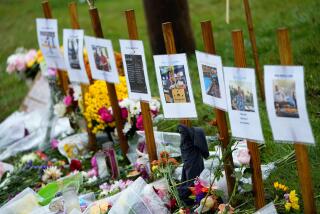Army Finds No Evidence of 1943 Massacre
- Share via
WASHINGTON — A book alleging that white soldiers massacred 1,200 black comrades on a Mississippi army base in 1943 is “a work of fiction,” says the Defense Department official who led an Army investigation into the claim.
An Army report to be released today says it is intended “to put to rest any concern that these alleged events were even remotely possible. All of the nearly 4,000 men who were assigned to the 364th Infantry in 1943 have been traced to their separation from military service.”
However, NAACP President Kweisi Mfume asked Attorney General Janet Reno on Monday to investigate the Army’s findings that there were no such killings at Mississippi’s Camp Van Dorn, as claimed by a book titled “The Slaughter: An American Atrocity” by Carroll Case.
Case, a former president of a savings and loan association in Mississippi, could not be reached for comment Wednesday. His book drew considerable attention in the black community when it appeared in 1998 and was discussed on Black Entertainment Television.
“We aren’t saying the Army is wrong, but we don’t have the personnel here to confirm what they found,” NAACP spokesman John C. White said Wednesday. “We are saying we need a third party to offer an objective look at the matter.
“If the Justice Department signs off on the Army report, we will be satisfied,” White said.
William E. Leftwich III, deputy assistant secretary of defense for equal opportunity, who has led the Army investigation for more than a year, branded the book “a work of fiction and a marketing grab” and said he is confident the Army report will withstand scrutiny.
“This was a massive undertaking. We have done all the research. Yet, Mr. Case has not been able to name one individual who took part in this alleged atrocity or any individual who disappeared in this case,” Leftwich said in an interview Wednesday.
Case’s book carries two accounts--a 54-page segment, which he portrays as truthful, and a 246-page “fact-based novel” set in present day Mississippi and portraying a racial crime similar to that detailed in the first part.
In the first part, Case says that as many as 1,200 soldiers, or one-third of the all-black 364th Infantry Regiment at Camp Van Dorn, were branded as mutineers and troublemakers by white superiors.
Citing as his source Bill Martzall, a former military policeman who died in 1989, Case said the soldiers were marched outside their barracks and cut down with gunfire by white soldiers in late 1943. The bodies were taken away by train for mass burial, the book asserts.
Case alleged the killings were the subject of a cover-up that could have reached as high as President Franklin D. Roosevelt.
“We have a story and a novel, a self-published book that was never vetted as any historical piece would be,” Leftwich said. “A lot of this borders on irresponsible.”
The Associated Press obtained a copy of the nearly inch-thick Army report. It lists members of the 364th Infantry Regiment taken from payroll and discharge information and carries an analysis of aerial photos of where the bodies were supposedly buried. It also contains interviews with 15 veterans who served at Camp Van Dorn in 1943.
“We have 100% certainty on the records,” said Army Lt. Col. Charles Graul, a military historian at the U.S. Army Center of Military History who also worked on the investigation.
The Army report said the rumors of a slaughter of black soldiers may have arisen from “reports of a large street fight among soldiers that resulted in the shooting of two men in 1944.”
Allegations of a massacre at the camp have been legendary in Mississippi for years. Case said in an earlier interview that he first heard the story as a boy.
And the tales were given credence by echoes of Mississippi’s violent past, such as the arrest two years ago of three aging Klansmen in the 1966 murder of civil rights activist Vernon Dahmer Sr.
Rusty Denman, the book’s publisher, said he is encouraged by the NAACP’s request for a fresh investigation, saying he’s not convinced the Army report is accurate.
He drew a comparison to the killing of Korean civilians at No Gun Ri during the Korean War. For years the Army asserted it had no records of such an event, “and then-- boom!--there it is,” he said.
More to Read
Sign up for our Book Club newsletter
Get the latest news, events and more from the Los Angeles Times Book Club, and help us get L.A. reading and talking.
You may occasionally receive promotional content from the Los Angeles Times.








